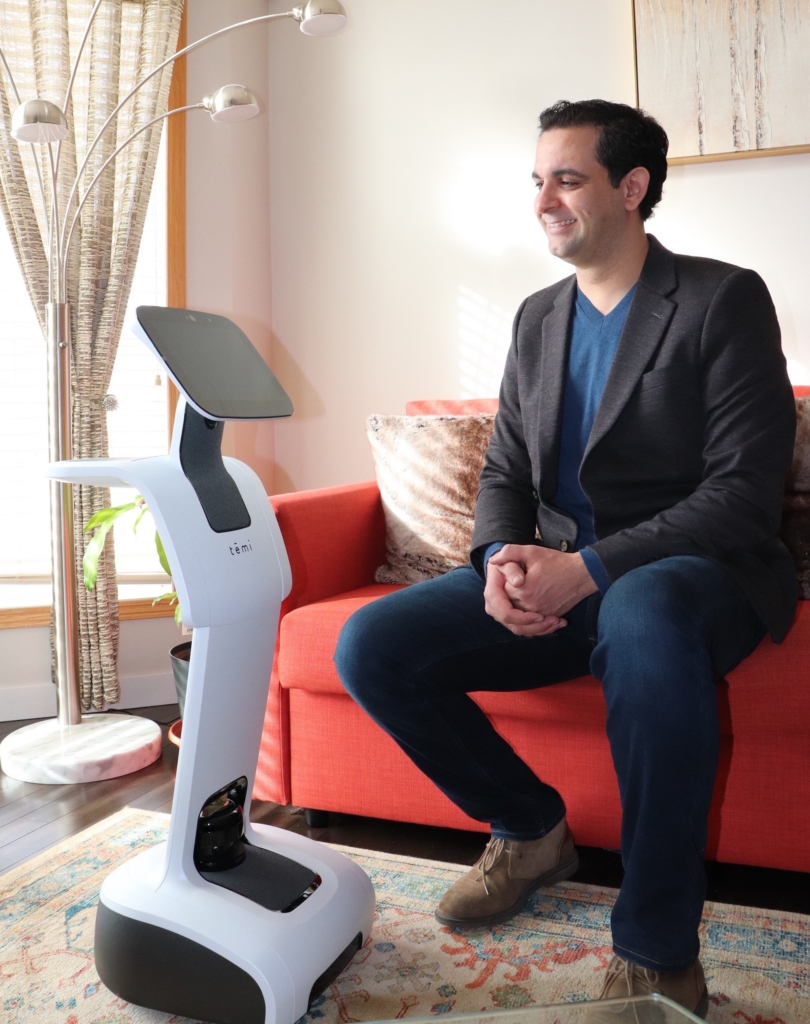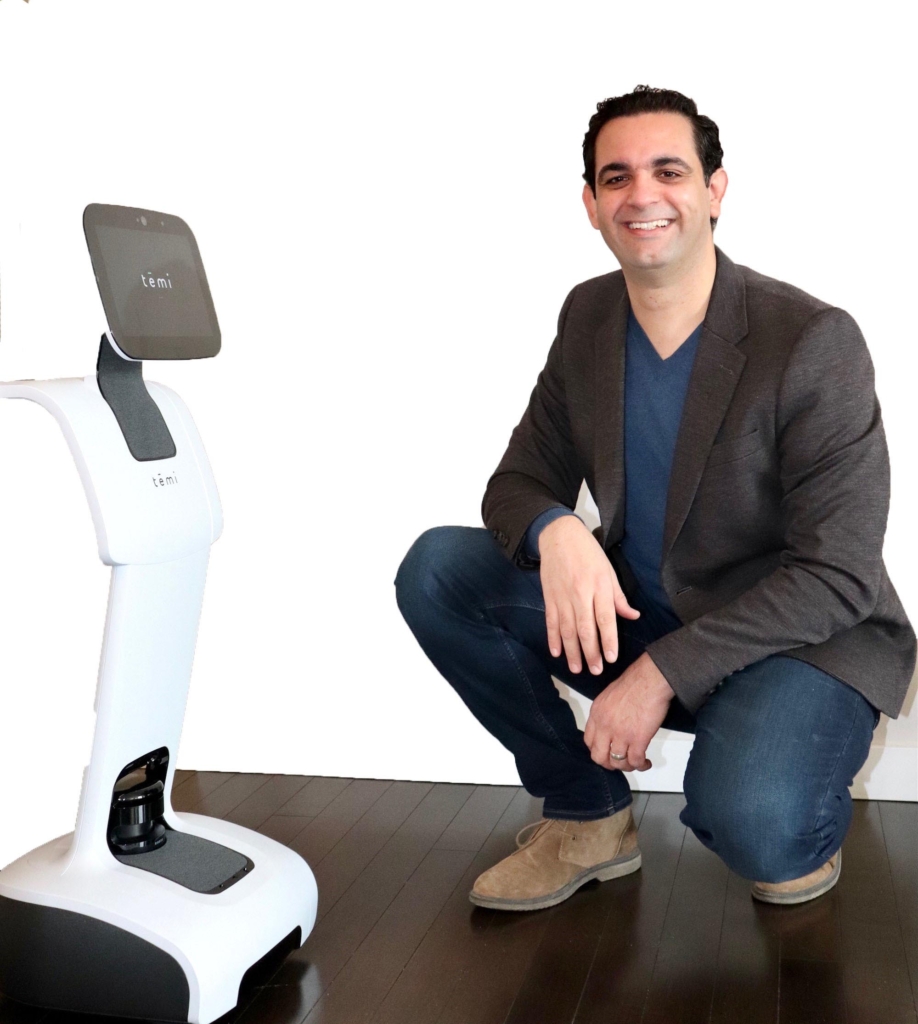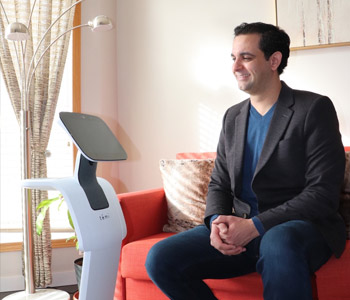Written by: Brian Cole

A woman learns that her mother has just been diagnosed with mild to moderate dementia.
Naturally, she wants to do everything she can to support her mother’s decision to stay living at home on her own, at least for the foreseeable future.
There is only one problem. The woman has a full-time job, three children to care for, and lives 20 kilometres away. Looking in on Mom every day or even a few times a week will be difficult.
The scenario outlined above is becoming increasingly common in Manitoba. As the province’s population gets a little older every year, more families are grappling with an extremely complex question: How do you support a loved one with dementia who is capable of living on their own?
As it turns out, Reg Urbanowski may have an answer to that question: robots.
An occupational therapist and Dean of the College of Rehabilitation Sciences in the Rady Faculty of Health Sciences at the University of Manitoba, Urbanowski believes that caregivers and family members can use a specific type of robot, known as a telepresence robot, to “look in” on people with dementia who are living alone.
To test his theory, Urbanowski and his research team — which includes co-investigator Amine Choukou as well as members from the Faculties of Business Administration and Computer Science — have launched a study that involves embedding three different models of telepresence robots with about 15 Manitoba families. The objective is two-fold: to determine whether telepresence robots can assist in caring for people living with dementia; and to identify whether there is an opportunity to develop and build such robots here in Manitoba.
The research project is the first of several to be funded through a new strategic partnership between the Victoria General Hospital Foundation and Research Manitoba. Each party is contributing $180,000 towards the $360,000, six-month project.
Charlene Rocke, Executive Director of the Victoria General Hospital Foundation, says the robot research project is a perfect fit for her organization. Both the hospital and the foundation have a long history of supporting efforts to help older adults live independently for as long as possible.
“It is a good way for us to launch this strategic partnership with a relevant project,” she says.
Judi Bahl, Manager of Strategic Relationships for Research Manitoba, agrees.
“Victoria General Hospital Foundation is really focused on community care and mental health and aging in place… so it’s right in their wheelhouse,” she says.

The project will help address a pressing issue in this province.
As many as 23,000 Manitobans have some form of dementia, and that number is expected to reach 40,700 by 2038, according to the Alzheimer Society of Manitoba.
Many people with early or moderate dementia are capable of living on their own, provided they receive some support. But providing that care can create challenges for family members or informal caregivers, particularly those who may also have other responsibilities, such as a job or kids to care for. It doesn’t take long before the financial and emotional impacts associated with missing work or other family responsibilities start to add up.
Which is where telepresence robots may be able to help.
“We were looking for a way to reduce the burden for the informal caregiver, and we came across this idea for a way to communicate with people… so that a parent or daughter could be in touch with a mother or father while they were at home,” says Urbanowski.
As he noted in his research proposal: “Telepresence robots provide an effective solution for minimizing caregiver burden. (They) will especially be useful for those caregivers who have career or other out-of-home activities.”
Although telepresence robots come in different shapes and sizes, the ones being tested by Urbanowski all share a similar look — think of a stand-up vacuum cleaner attached to an iPad.
While capabilities can vary, depending on the model, all can be activated remotely via a smartphone or tablet, and all possess audio and visual communication capabilities, essentially allowing the operator to be “in the room” to interact with Mom or Dad.
Some of the robots being tested can be guided remotely by a controller app similar to the way a mouse is used on a desktop computer. Others are guided by touch-screen technology that incorporates a camera to navigate a room. A third type of robot uses “tap” technology. “You just tap the robot and it follows you… just like a little puppy would,” says Urbanowski.
Some robots have the ability to play games, while others can be programmed to provide reminders of when medication needs to be taken. “You can also load it up with exercises, so it says, ‘Reg, it’s 3 p.m. Time for your exercise, and a little video would come on (with an exercise routine),’” says Urbanowski. This would help ensure that Mom or Dad was getting the exercise they needed to maintain their health and well-being, he says.

Similarly, you can use the robot to make sure your Mom or Dad is taking their medication.
“You can actually watch them take their pill, which is not something medication dispensers can do,” says Urbanowski.
The findings of the research project will be shared with a variety of stakeholders, including the Alzheimer Society of Manitoba, an advocacy group for people living with dementia.
Erin Crawford, Program Director with the Alzheimer Society of Manitoba, says she is hopeful that telepresence robots will prove beneficial, particularly when it comes to cueing people with dementia to do certain things at certain times.
As she explains, a person might be perfectly capable of taking their pills, provided they remember when to take them. “It means that family members that can’t be there, for whatever reason, know that those things are still happening,” she says.
In addition to determining whether robots can help keep tabs on a loved one, Urbanowski says the research project will also look at whether they can help improve the mental outlook of people with dementia.
“The other piece on this is we are actually going to measure what happens to relationships,” he says. “Does a robot make people feel more isolated or less isolated than they were before?”
Urbanowski says the issue of social isolation is particularly relevant now during the COVID-19 pandemic. “That’s the big thing now because these are the folks you are not supposed to visit because they are vulnerable,” he says.
An obvious question in this regard would be whether communicating via telepresence robot differs much from talking via/through mediums such as Skype, Face Time, or even by phone. But Urbanowski believes the telepresence robot offers an opportunity for more human-like contact.
“My theory is that the use of a robot is different from talking on a phone,” he says. “You don’t form the same kind of relationship with phones as you do with a machine that is at your height and you are looking at them. That’s why they call it telepresence. It’s like you are there. Eventually, if I am talking on it to you, over time, it is like you are talking to me.”
Crawford adds: “It doesn’t replace the need for in-person contact, but it can enhance those connections.”
While the robots being tested are considered state-of-the-art in their field, Urbanowski does see an opportunity for innovation and economic development.
“At the end of the day, there has not been a lot of research on this for people with dementia living in their own homes,” he says. “One of the reasons we wanted to do this project… is to find out what characteristics a robot needs (to be effective in supporting people living at home with mild to moderate dementia). Because we can build it if it is not there.”
Indeed, the business side of the research project is not to be overlooked. In addition to testing the effectiveness of telepresence robots, Urbanowski says his research team will also be examining whether it makes any sense to build one locally.
“When we initially started this journey, we found a company in Europe that had something for people with dementia for $12,000. I mean, who could afford that?”
The robots being tested here are not made specifically for people with dementia, and range in price between $2,500 and $5,000 each. What, if anything, can be done to make them more suitable for people living with dementia, and how much that would cost, remains to be seen.
“The whole premise of this…is it has to be affordable, it has to be accessible and it has to be effective,” he says. “One of the reasons we have the Faculty of Business person involved is (to determine) if there is a business case for this… If a family invests in this, it has to be effective. It’s not just a toy.”
Brian Cole is a Winnipeg writer.
Meet the research team
In addition to Reg Urbanowski, the telepresence report research team includes:
Amine Choukou, Assistant Professor, Department of Occupational Therapy, University of Manitoba (robotics, dementia and technology acceptance)
Celine Latulippe, Associate Professor, Department of Computer Science, University of Manitoba (technology and caregiver)
James Young, Associate Professor, Department of Computer Science, University of Manitoba (human-robot interaction)
Alan Katz, Director of the Manitoba Centre for Health Policy and professor in the Departments of Community Health Sciences and Family Medicine (program design; policy implications)
Nathan Greidanus, Associate professor, Business Administration, Asper Faculty of Business, University of Manitoba.
Erik Koskie, Department of Occupational Therapy, University of Manitoba
Celeste St. Lawrence, Department of Occupational Therapy, University of Manitoba
Brittany Roschuk, Department of Occupational Therapy, University of Manitoba
Telepresence robots

Here is a brief description of the three telepresence robots that are being tested by Reg Urbanowski and his team. All robots allow the operator to connect from a remote location and communicate with an individual through a tablet-like screen, similar to an iPad.
Ohmni SuperCam: Remote operators can use a keyboard to move this robot around the room or down the hallway. It features a speaker, microphone and two cameras that allow the robot to see and avoid obstacles.
TEMI: This intelligent home assistant robot responds to the user’s voice. It can autonomously navigate around your home and play music, start video chats, and help with other daily tasks.
Double 3: This machine features 3D sensors and self-driving technology. Once you connect to the robot from a remote location, the machine’s camera will provide you with an image of the room. Click on the floor in front of the robot, and it will drive there, avoiding any obstacles along the way.

